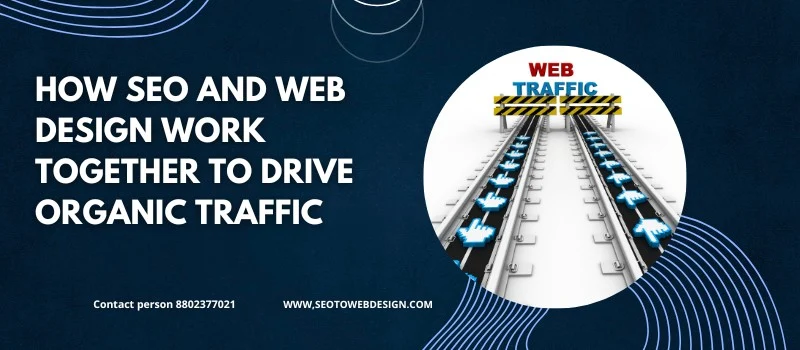In this blog, we will explore how SEO and web design complement each other and share practical tips on how to make both work in harmony to drive traffic and improve user experience.
1. User Experience (UX) and SEO: The Perfect Pair
User experience (UX) is at the heart of both web design and SEO. Search engines, particularly Google, prioritize websites that provide a seamless, intuitive experience for users. If visitors have a hard time navigating your site or if they are frustrated by its layout, they are likely to leave quickly. High bounce rates and poor user engagement send negative signals to search engines, which can result in lower rankings.
Tip: To improve both UX and SEO, ensure your website has clear navigation, an intuitive layout, and a responsive design. These features not only enhance the user experience but also help search engines crawl your site efficiently, contributing to better rankings.
2. Mobile Optimization: SEO’s Role In Web Design
With mobile usage dominating internet browsing, Google has adopted a mobile-first indexing policy. This means Google’s search algorithms prioritize mobile versions of websites for ranking purposes. If your website isn’t mobile-friendly, you risk missing out on potential traffic and harming your SEO performance.
Tip: Incorporate responsive design principles that automatically adjust your website’s layout based on the user’s device. By ensuring your site is mobile-friendly, you’ll meet Google’s mobile-first indexing requirements and enhance the user experience for mobile visitors.
3. Page Speed: A Web Design And SEO Priority
The loading speed of your website is another factor that heavily influences both UX and SEO. Google has confirmed that page speed is a ranking factor, and slower websites tend to have higher bounce rates. If your site takes too long to load, visitors are likely to leave before even seeing your content, which negatively affects your SEO rankings.
Tip: Optimize your website’s speed by compressing images, minifying code (CSS, JavaScript, HTML), and utilizing browser caching. Using a Content Delivery Network (CDN) can also help serve your website’s content faster to users from different locations.
4. SEO-Friendly URL Structure
A website’s URL structure is an essential aspect of both web design and SEO. A clean, descriptive URL is easier for both users and search engines to understand. Long, complicated URLs with unnecessary characters or parameters can harm your website’s rankings and confuse visitors.
Tip: Design your URLs to be short, descriptive, and keyword-rich. Use hyphens to separate words, and avoid using special characters. Simple, easy-to-read URLs contribute to a better user experience and make it easier for search engines to index your pages.
5. The Role Of Content And Design In SEO
Content is king when it comes to SEO, but design plays a pivotal role in how content is presented. High-quality, relevant content can’t work its magic if it’s hidden behind a clunky design. Visitors are more likely to engage with and share content that is well-organized and visually appealing.
Tip: Incorporate clear typography, easy-to-read fonts, and engaging visual elements like images, videos, and infographics into your content. Proper use of headings (H1, H2, H3) will also improve both readability and SEO by helping search engines understand the structure of your content.
6. Internal Linking: Enhancing SEO Through Web Design
Internal linking helps search engines crawl your site and understand its structure. Properly designed websites make it easy to link related pages together, which can help improve your site’s SEO by spreading link equity and boosting the rankings of important pages.
Tip: Make sure your web design incorporates a clean, logical internal linking structure. Use anchor text that includes relevant keywords, and ensure all important pages are accessible within a few clicks from your homepage.
7. Visual Appeal And Click-Through Rates
The visual appeal of your website design plays an important role in improving click-through rates (CTR). A website that is visually pleasing and well-organized encourages visitors to stay longer and explore more. Higher CTRs indicate to search engines that your site is providing value to users, which can result in improved rankings.
Tip: Invest in professional web design that aligns with your brand identity and appeals to your target audience. Make sure your call-to-action buttons, product pages, and other critical elements stand out, prompting visitors to take action.
8. Schema Markup: Enhancing Visibility In Search Results
Schema markup is a powerful tool for improving SEO that is often overlooked in web design. Schema provides search engines with additional information about your website’s content, making it easier for them to display rich snippets (e.g., product ratings, event details) in search results. Rich snippets improve visibility, attract more clicks, and increase organic traffic.
Tip: Incorporate schema markup into your web design to provide search engines with structured data about your content. This will enhance your site’s appearance in search results and drive more traffic to your website.
At Seotowebdesign, we understand the importance of creating websites that are both aesthetically pleasing and SEO-optimized. By following the tips outlined in this blog, you can improve your website’s performance, increase your visibility on search engines, and deliver a better experience for your users.

